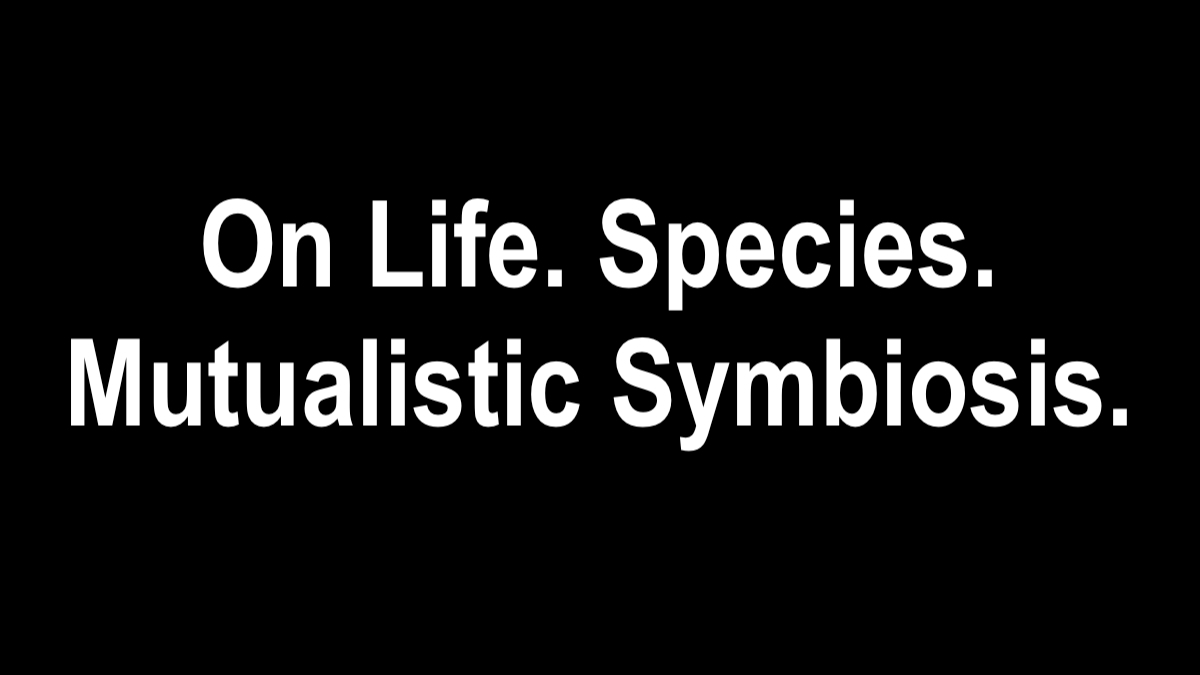On: Life. Species. Mutualistic Symbiosis.
Definitions…
- Life is a quality that distinguishes matter that has biological processes, such as signalingand self-sustaining processes, from matter that does not. It is defined descriptively by the capacity for homeostasis, organisation, metabolism, growth, adaptation, response to stimuli, and reproduction. All life over time eventually reaches a state of death, and none is immortal. Many philosophical definitions of living systems have been proposed, such as self-organizing systems. Viruses in particular make definition difficult as they replicate only in host cells. Life exists all over the Earth in air, water, and soil, with many ecosystems forming the biosphere. Some of these are harsh environments occupied only by extremophiles.
- Life. Noun. 1c. an organismic state characterized by capacity for metabolism (see METABOLISM sense 1), growth, reaction to stimuli, and reproduction
- A species (pl.: species) is a population of organisms in which any two individuals of the appropriate sexesor mating types can produce fertile offspring, typically by sexual reproduction.[1] It is the basic unit of classification and a taxonomic rank of an organism, as well as a unit of biodiversity. Other ways of defining species include their karyotype, DNA sequence, morphology, behaviour, or ecological niche. In addition, paleontologists use the concept of the chronospecies since fossil reproduction cannot be examined. The most recent rigorous estimate for the total number of species of eukaryotes is between 8 and 8.7 million.[2][3][4] About 14% of these had been described by 2011.[4] All species (except viruses) are given a two-part name, a “binomial”. The first part of a binomial is the genus to which the species belongs. The second part is called the specific name or the specific epithet (in botanical nomenclature, also sometimes in zoological nomenclature). For example, Boa constrictor is one of the species of the genus Boa, with constrictor being the species’ epithet.
- Species. Noun. 1d. a category of biological classification ranking immediately below the genus or subgenus, comprising related organisms or populations potentially capable of interbreeding, and being designated by a binomial that consists of the name of a genus followed by a Latin or latinized uncapitalized noun or adjective agreeing grammatically with the genus name
- Symbiosis (Ancient Greek συμβίωσις symbíōsis: living with, companionship < σύν sýn: together; and βίωσις bíōsis: living)[2] is any type of a close and long-term biological interaction, between two organisms of different species. The two organisms, termed symbionts, can be either in a mutualistic, a commensalistic, or a parasitic relationship.[3] In 1879, Heinrich Anton de Bary defined symbiosis as “the living together of unlike organisms”. The term is sometimes more exclusively used in a restricted, mutualistic sense, where both symbionts contribute to each other’s subsistence.[3] Symbiosis can be obligatory, which means that one, or both of the symbionts depend on each other for survival, or facultative (optional), when they can also subsist independently.
- Symbiosis, noun. Biology. Association of two different organisms (usually two plants, or an animal and a plant) which live attached to each other, or one as a tenant.
Learn more about Mutualistic symbiosis:
- PRINCETON UNIVERSITY. When corals met algae: Symbiotic relationship crucial to reef survival dates to the Triassic. Nov. 2, 2016.
- Mutualistic Symbiosis is an extremely successful strategy in our Natural World.


